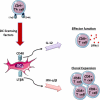The Lymphotoxin Network: orchestrating a type I interferon response to optimize adaptive immunity
- PMID: 24698108
- PMCID: PMC4081445
- DOI: 10.1016/j.cytogfr.2014.02.002
The Lymphotoxin Network: orchestrating a type I interferon response to optimize adaptive immunity
Abstract
The Lymphotoxin (LT) pathway is best known for its role in orchestrating the development and homeostasis of lymph nodes and Peyer's patches through the regulation of homeostatic chemokines. More recently an appreciation of the LTβR pathway in the production of Type I interferons (IFN-I) during homeostasis and infection has emerged. LTβR signaling is essential in differentiating stromal cells and macrophages in lymphoid organs to rapidly produce IFN-I in response to virus infections independently of the conventional TLR signaling systems. In addition, LTβR signaling is required to produce homeostatic levels of IFN-I from dendritic cells in order to effectively cross-prime a CD8+ T cell response to protein antigen. Importantly, pharmacological inhibition of LTβR signaling in mice has a profound positive impact on a number of autoimmune disease models, although it remains unclear if this efficacy is linked to IFN-I production during chronic inflammation. In this review, we will provide a brief overview of how the "Lymphotoxin Network" is linked to the IFN-I response and its impact on the immune system.
Keywords: Autoimmunity; Dendritic cells; Interferon (IFN); Lymphotoxin-αβ (LTαβ); Stromal cells.
Copyright © 2014 Elsevier Ltd. All rights reserved.
Figures


Similar articles
-
A Lymphotoxin/Type I IFN Axis Programs CD8+ T Cells To Infiltrate a Self-Tissue and Propagate Immunopathology.J Immunol. 2015 Nov 15;195(10):4650-9. doi: 10.4049/jimmunol.1501053. Epub 2015 Oct 12. J Immunol. 2015. PMID: 26459352
-
Lymphotoxin in physiology of lymphoid tissues - Implication for antiviral defense.Cytokine. 2018 Jan;101:39-47. doi: 10.1016/j.cyto.2016.08.018. Epub 2016 Sep 9. Cytokine. 2018. PMID: 27623349 Free PMC article. Review.
-
Sustained innate interferon is an essential inducer of tertiary lymphoid structures.Eur J Immunol. 2024 Oct;54(10):e2451207. doi: 10.1002/eji.202451207. Epub 2024 Jul 9. Eur J Immunol. 2024. PMID: 38980268
-
LTβR and CD40: working together in dendritic cells to optimize immune responses.Immunol Rev. 2011 Nov;244(1):85-98. doi: 10.1111/j.1600-065X.2011.01056.x. Immunol Rev. 2011. PMID: 22017433 Review.
-
Biology and signal transduction pathways of the Lymphotoxin-αβ/LTβR system.Cytokine Growth Factor Rev. 2011 Oct-Dec;22(5-6):301-10. doi: 10.1016/j.cytogfr.2011.11.007. Cytokine Growth Factor Rev. 2011. PMID: 22152226 Review.
Cited by
-
The viral innate immune antagonism and an alternative vaccine design for PRRS virus.Vet Microbiol. 2017 Sep;209:75-89. doi: 10.1016/j.vetmic.2017.03.014. Epub 2017 Mar 18. Vet Microbiol. 2017. PMID: 28341332 Free PMC article. Review.
-
Targeting an alternate Wilms' tumor antigen 1 peptide bypasses immunoproteasome dependency.Sci Transl Med. 2022 Feb 9;14(631):eabg8070. doi: 10.1126/scitranslmed.abg8070. Epub 2022 Feb 9. Sci Transl Med. 2022. PMID: 35138909 Free PMC article.
-
LTβR signalling preferentially accelerates oncogenic AKT-initiated liver tumours.Gut. 2016 Oct;65(10):1765-75. doi: 10.1136/gutjnl-2014-308810. Epub 2015 Jul 23. Gut. 2016. PMID: 26206664 Free PMC article.
-
Causal relationships between circulating inflammatory cytokines and diffuse large B cell lymphoma: a bidirectional Mendelian randomization study.Clin Exp Med. 2023 Dec;23(8):4585-4595. doi: 10.1007/s10238-023-01221-y. Epub 2023 Nov 1. Clin Exp Med. 2023. PMID: 37910257
-
The Lymphotoxin β Receptor Is Essential for Upregulation of IFN-Induced Guanylate-Binding Proteins and Survival after Toxoplasma gondii Infection.Mediators Inflamm. 2017;2017:7375818. doi: 10.1155/2017/7375818. Epub 2017 Aug 6. Mediators Inflamm. 2017. PMID: 28845089 Free PMC article.
References
-
- Granger GA, Williams TW. Lymphocyte cytotoxicity in vitro: activation and release of a cytotoxic factor. Nature. 1968;218:1253–4. - PubMed
-
- Browning JL, Ngam-ek A, Lawton P, DeMarinis J, Tizard R, Chow EP, et al. Lymphotoxin b, a novel member of the TNF family that forms a heteromeric complex with lymphotoxin on the cell surface. Cell. 1993;72:847–56. - PubMed
-
- Crowe PD, VanArsdale TL, Walter BN, Ware CF, Hession C, Ehrenfels B, et al. A lymphotoxin-beta-specific receptor. Science. 1994;264:707–10. - PubMed
-
- De Togni P, Goellner J, Ruddle NH, Streeter PR, Fick A, Mariathasan S, et al. Abnormal development of peripheral lymphoid organs in mice deficient in lymphotoxin. Science. 1994;264:703–7. - PubMed
Publication types
MeSH terms
Substances
Grants and funding
LinkOut - more resources
Full Text Sources
Other Literature Sources
Medical
Research Materials

